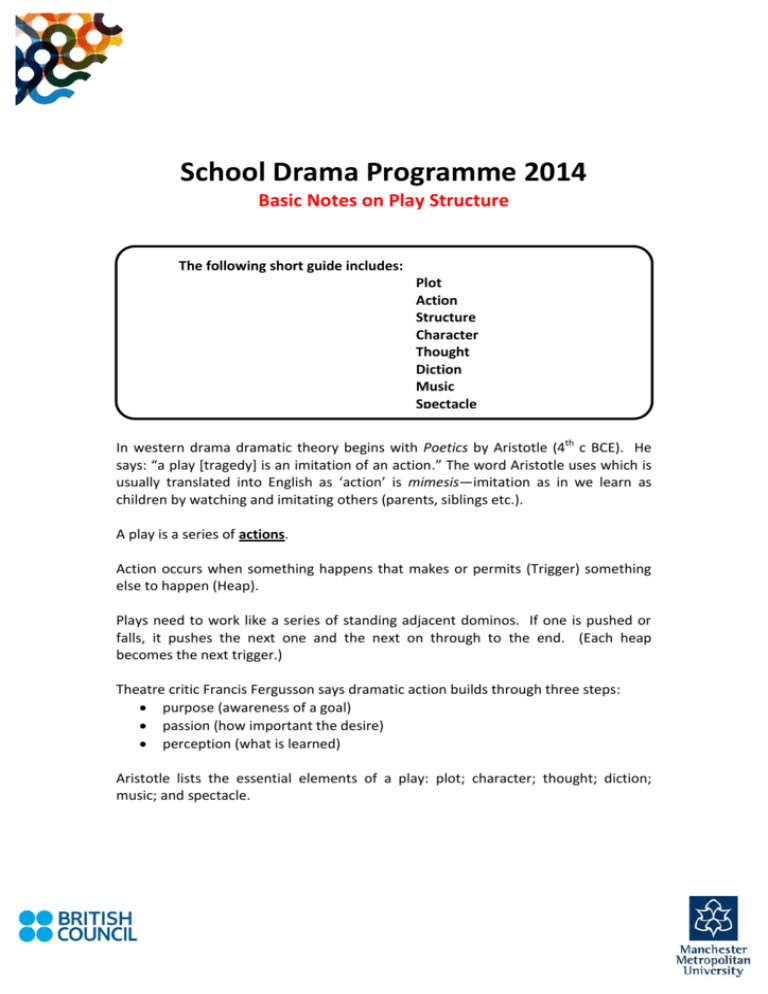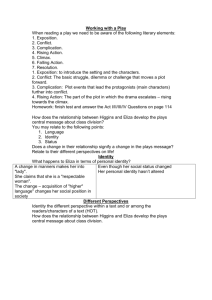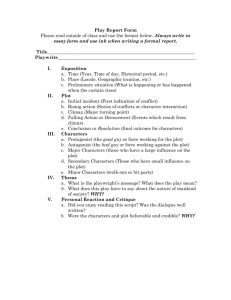Play Structure Basics: Plot, Character, Action & More
advertisement

School Drama Programme 2014 Basic Notes on Play Structure The following short guide includes: Plot Action Structure Character Thought Diction Music Spectacle In western drama dramatic theory begins with Poetics by Aristotle (4th c BCE). He says: “a play [tragedy] is an imitation of an action.” The word Aristotle uses which is usually translated into English as ‘action’ is mimesis—imitation as in we learn as children by watching and imitating others (parents, siblings etc.). A play is a series of actions. Action occurs when something happens that makes or permits (Trigger) something else to happen (Heap). Plays need to work like a series of standing adjacent dominos. If one is pushed or falls, it pushes the next one and the next on through to the end. (Each heap becomes the next trigger.) Theatre critic Francis Fergusson says dramatic action builds through three steps: purpose (awareness of a goal) passion (how important the desire) perception (what is learned) Aristotle lists the essential elements of a play: plot; character; thought; diction; music; and spectacle. PLOT plot (action) vs. story (narrative) Plot is the careful arrangement of a series of actions. Plays (especially longer ones) can have more than one plot—sub-plots. Usually short plays are better as a single plot. ACTION The Greeks use the word “AGON” –meaning struggle or battle—not a debate more like a wrestling match. Dramatic conflict is distinct from other kinds of conflict. A play's conflict is between what someone wants and what hinders the want: the obstacle of which can be another person, or any of the following: me against myself; me against other individuals; me against society; me against fate, or the universe, or natural forces, or God, or the gods. STRUCTURE Aristotle says that a play must have a beginning, middle and an end. This is both simple and profound. Another way to imagine a plot: 1. Stasis. 2. Intrusion. 3. Battle for new stasis initiated by intrusion. 4. New stasis. BEGINNING - Stasis is motionless: a condition of balance among various forces; a standing still; an unchanging stability; a state in which all forces balance each other, resulting in no movement. Inciting incident (Intrusion) is pushing, thrusting, or forcing in that upsets the balance. When deciding where to begin remember that it is possible to begin near the end of the plot (late attack) and fill in the important past information through “exposition” or to begin at the beginning of the plot: “an early attack.” Exposition can be information known to everyone on stage or information known to a few characters that they share with a character who does not know this. Good exposition is directly relevant to the action in that it uses the past to propel the present. MIDDLE - The rising action is a series of complications that builds to the climax. END - Falling action or denouement - the wrapping up. A good play is complete, self-contained, deliberately shaped, and internally consistent. CHARACTER Character is revealed through action (what the character does). There is a difference between Avowed action (What I say I will do) VS True action (What I actually do.) Character is revealed if these two types of action are not basically the same. Plays only contain the bones of a character—the actor completes the character. When pretending to be someone else you must portray believable human behavior, it is OK to begin with a stereotype but make sure you end up with an individual. Some types of characters: Extraordinary characters Representative or Quintessential characters Stock characters Characters with a dominant trait (the miser) Minor characters Narrator or Chorus Characters in plays talk a lot. A human being talks in order to get what he or she wants. What a character wants motivates talking. There should be no speech without motivation. Why is something said aloud? What is wanted (objective)? Why it is wanted (motivation)? What is in the way (obstacle)? Obstacle: A person or thing that prevents a character from achieving what she/he wants--- contributes to dramatic conflict. An obstacle is any resistance to my having what I want. You do not really know a play until you see how every word is intended by its speaker to overcome some obstacle to what the speaker wants. THOUGHT This is the meaning or theme, and is usually but not always implied rather than stated. To paraphrase Archibald McLeish: “A play should be and not mean”. To do this, you can use allegory, symbols and images. An image is something we already know or can easily be told that is used to describe, illuminate, or expand upon something we do not know or cannot easily be told. DICTION The use of language—words and a way of speaking that is appropriate to each character. The characters must not all sound the same. Language is always arranged and heightened even when it appears to be “natural” MUSIC It can mean music and/or song in the traditional sense; HOWEVER every day speech uses the elements of pitch, stress, volume, tempo, duration and quality which are “musical” characteristics. SPECTACLE All the visual elements, including: movement and spatial relations of the characters; Lighting; sets; costumes; etc. NOTES A play gives only results: the words spoken. A playwright must imagine the motivation and obstacles that lead to the words. The actors and directors will then supply their own motivations and obstacles. There is no ONE right way to perform a play. As a playwright be conscious of what information has been revealed and what information has been withheld. Choose carefully when information is provided in the play. Do not reveal information prematurely or you might undermine the foundation of the play like high-speed termites. In our not knowing, lies the play’s adventure. Things theatrical are all things that elicit strong audience response. Good playwrights put their most important material into their most theatrical moments.








